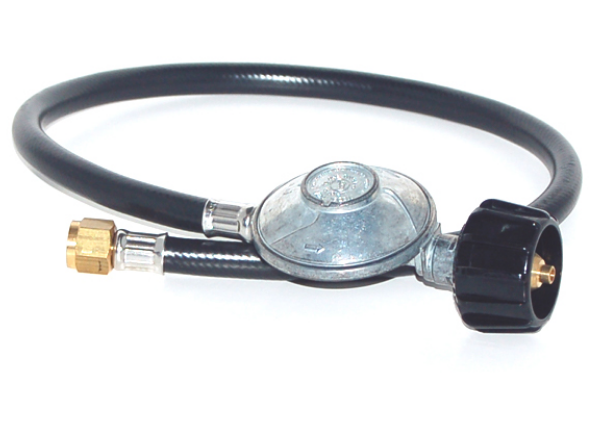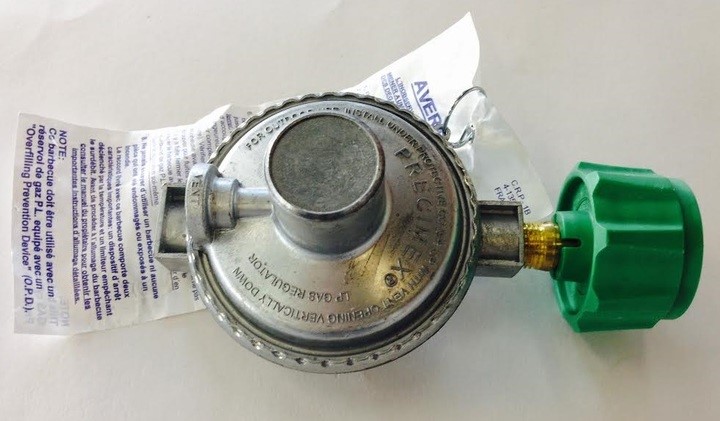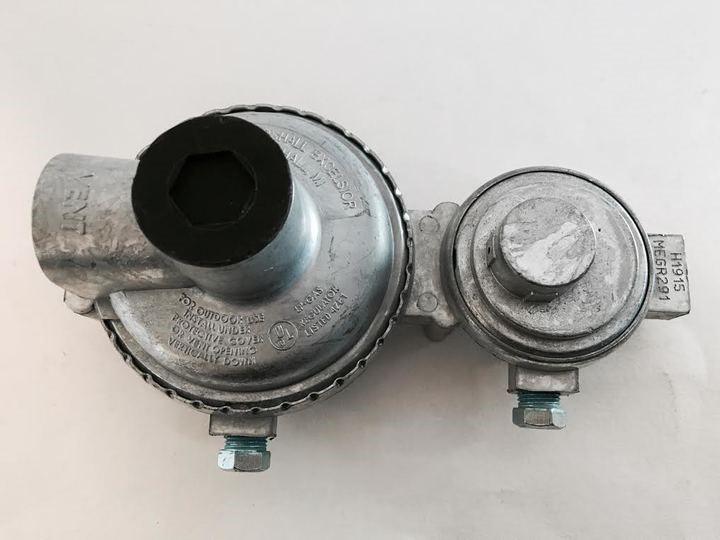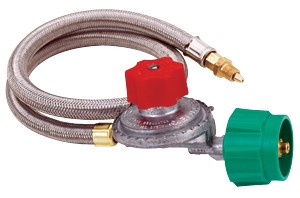LP Gas Regulators 101: How to Find or Replace a Gas Grill Regulator
Complete Guide to LP Regulators – How to Choose the Right Regulator for Your Grill
The BBQ grill is a favorite backyard appliance of homeowners everywhere. There’s nothing better than perfectly grilled burgers or steamy, seared steaks to be enjoyed with friends and family during the summer (or any season, if you’re bold enough).
It takes power, precision, and heat to cook your food to perfection. And if you have a propane gas powered grill, you have the benefit of spot-on temperature control.
Part of your gas grill setup includes an important part called the regulator. Without this, you don’t have proper flow of propane and pressure to your grill.
In this guide, we’ll cover what an LP Gas Regulator is, how it works, and how to choose the right type for your grill.

What is an LP Gas Regulator?
An LP gas regulator (or propane gas regulator) is the part of your grill that controls the flow of gas from the propane tank to the heating appliance. It also serves as a safety barrier between the heating element and the high-pressure propane tank.
Purposes:
- Controls flow of gas
- Regulates pressure
- Safety feature between propane tank and grill
In other words, the main purpose of the gas grill regulator is to funnel the propane down to a safe pressure level. Too low and your grill may not heat up. Too high and there may be a flare up (or worse).
How it Works
The regulator is screwed onto the propane take and controls the flow of gas to the heating element (flame). A higher flow of gas results in a bigger flame and, therefore, more heat. Less gas flow results in a smaller flame and less heat.
The regulator also includes something called a bypass: a plastic mechanism that shuts off the gas supply if there is no pressure in the hose leading from the propane tank. When this happens, it is likely due to a leak or because a grill burner was left on for too long.
Are All Gas Grill Regulators the Same?
Every propane gas grill uses an LP regulator, but not all regulators are created equal. Though the purpose is the same, different types of setups require different types of regulators. The type of regulator a grill needs is based on the specific propane application requirements.
There are many types of gas regulators available including: High-Pressure Regulators, First Stage Regulators, Second Stage Regulators, Integral Twin Stage Regulators and Appliance Regulators.
In summary, the saying "a regulator is a regulator" is FALSE.
Types of LP Gas Regulators
Different types of regulators are available for different pressure capacities. The required downstream of gas is what determines the type of regulator your grill needs. Some grills use multiple regulators to increase efficiency
A regulator capacity is based on BTUs. When determining the regulator you need for you grill (or any LP gas appliance), you need to know the total BTUs of the appliance or the total BTUs that you are planning to use with the regulator.
Basic Regulator Kit

Basic hose and regulator kits are low pressure regulators that will only have a BTU capacity of between 50,000 to 60,000 BTUs. This means that any appliances that have a larger rating will not work with this regulator kit. Grills over 60,000 BTUs (TOTAL) you will need to go with one of the other regulator options.
That holds true for the same kits that have dual hoses for side burner applications. The kits are generally imported from overseas and do not have a high quality regulator on them. In addition, the hose is clamped onto the end of the regulator making it impossible to replace one piece of the kit. It also opens the door for more failure than connecting your hose and regulator using brass fittings.
First-Stage Regulators

First or Single Stage regulators are installed at the propane tank and connect to the service valve. A single-stage regulator has a large BTU capacity, up to 200,000 BTU's. This regulator is best used with larger sized grill (those with many burners). The first-stage regulators regulates the fluctuating tank pressure and delivers gas at a low pressure to the second-stage regulator.
In other words, its only job is to regulate the gas pressure to an appropriate level so that the second-stage regulator can work effectively. Therefore, both the first stage and second-stage regulators need to be properly matched so that the system is safe and works correctly.
Second-Stage Regulators

Second-stage regulators are installed downstream from the first-stage regulator. Its job isn’t to decrease tank pressure but to keep the system safe and functional. It further decreases the inlet gas pressure before it reaches the appliance (outlet pressure).
A two-stage regulator is rated to 175,000 BTU's and is best used on commercial products, as well as grills in the high-end market, with brands including Alfresco, Lynx and Twin Eagles. This is because these brands manufacture grills that are most like commercial quality. Although you could use a single-stage regulator with these grill brands, the two stage is a safer way to go since the second stage provides a backup.
In addition, in a built-in setting is necessary to use a stainless steel flex hose vs a rubber hose. This is for safety.
In the below picture you will see the female threaded ends of both the single and two stage regulator. These ends are 3/8 pipe. They will require a male pipe and most often a male flare (for the hose end) fitting. The male pipe end will need LP gas sealant (Yellow NOT white Teflon which is used for water not gas).

Integral Twin Stage Regulators
Integral or inline twin stage regulators are the most commonly used LP gas regulators. They are most used when hooking up multiple appliances.
However, they are not recommended if there is a long distance between the propane tank and the appliance/building because they won’t be able to supply enough propane over a long distance. In that case, you would likely want to use a two-stage system.
High-Pressure Regulators

High-pressure regulators, as the name implies, are propane regulators that regulate the high pressure between the propane tank and the appliance. These are typically used on fryers, NOT grills.
Red regulators typically signify “high pressure.” They can be used independently appliances where the gas demand is high..
What Type of Gas Grill Regulator Do I Need?
With so many regulators types available, your head may be spinning trying to figure out which option is best for your grill. Really, it comes down to the BTU requirements of your grill over your personal preference.
To determine what type of gas grill regulator you need, look at the BTUs.
Step 1. Look at the information sticker on your grill. Be sure to add all of the BTUs (main burners, rotisserie burner or side burner).
For example, on a Gas Grill, the information sticker will list the main burner BTUs (this may be in total main burner or per burner). If listed per burner, you must multiply the total # of burners times the BTU per burner. If there is a rotisserie burner or a side burner, those are listed separately, as they generally have a different BTU rating than the main burners.
As you can see from the below Napoleon Grill example, the information sticker (located on the back of the cart) shows the main burner BTU per burner. They also give you a total BTU (not all manufacturers do this). If your manufacturer doesn’t provide this number, you will need to multiply the BTU by the number of burners in the grill. You would then have to add the side burner BTU and the rotisserie burner to get the total BTU.

Step 2. If your grill is under 60,000 BTUs, a simple hose and a basic
regulator kit will be sufficient.
Step 3. If your grill is over 60,000 BTUs, then a single or two-stage
regulator may be the best option. In the above example, this grill is over
60,000 BTUs, so it would not be a good fit for a basic regulator kit.
Step 4. If you have a built-in grill, you will need to use a stainless steel
flex hose with your regulator. NO RUBBER hoses should
be used in an enclosed and vented cabinet.
We also want to be sure to
mention
appliance
regulators
. These regulators are essentially backup regulators and attach
to the manifold of the grill and should be on any built-in grill. Keep in mind,
you still need a regulator that goes to the tank.
Step 5: Make sure you check the BTU rating of the regulator you are
purchasing. If you need help choosing the right LP gas
regulator for your grill, please
contact
us. We’d be happy to help!
Tip: The safest way to go is by connecting the gas hose and regulator with a
brass fitting in a
custom hose
regulator kit. This way, if any piece were to go bad, it can be replaced.
In addition, it has less failure than in a "crimped" set up.
Replacing Your Gas Grill Regulator
Say you turn on your grill and realize that it’s not heating above 250 degrees Fahrenheit or so. This is likely due to a low flame caused by a decreased flow of gas. A low flow of gas is likely caused by an LP gas regulator issue.
And since you landed on this guide, it’s likely that you are either in search of a new regulator or are trying to decide on whether you need to replace the one you got. Fortunately, we’re here to help.
How Often Does My Regulator Need to Be Replaced?
It’s recommended that you replace your regulator every 15 years. This is because regulators, like any grill part, are prone to wear and tear. Some manufacturers recommend replacement every 20+ years or so, but you will need to double check with your manufacturer to see if this is the case. Note that gas regulators cannot and should not be repaired. They need to be replaced.
If it hasn’t yet been 15 years but your grill is having issues, it may still be time to purchase a replacement regulator.
Here are some possible causes of regulator issues:
- Broken bypass mechanism : a piece called the bypass regulates to flow of gas to the grill. If the bypass automatically shuts off the gas, this may be due to low pressure and your regulator may need to be replaced.
- Gas leak: If you are having regulators issues, they may be due to a gas leak in your hose. To troubleshoot this, shut off the gas and remove the regulator and hose from the propane tank. Spray soapy water around the regulator. Turn on the valve. If there’s a leak, you will see bubbles. Replace the hose and/or regulator.
- Loose/tight regulator : Regulators are meant to be removed, tightened, and adjusted by hand. Don’t use a wrench to adjust the regulator, as this can cause damage. Instead, use a lubricant if the regulator gets stuck.
- Total replacement : If you have already troubleshooted the possible issues above to no avail, your regulator likely needs to be replaced. Follow the steps in the previous section to find the right regular for your grill, or give us a call if you need assistance.
Where to Buy a New LP Gas Regulator
Remember, if your LP gas regulator is broken or just isn’t working, it cannot be repaired, only replaced. That means you will need to buy a new regulator kit or regulator system that’s appropriate for your grill (based on the BTU rating).
At The BBQ Depot, we help grill owners find the grill parts they need at a price they can afford. If you’re on the hunt for a new regular, visit our website to search for the parts you need or contact us for direct assistance .
LP Regulators – Frequently Asked Questions (FAQs)
Have more questions about what LP gas regulators are, how they work, and how to choose the right one for you? Check out our FAQ section below.
https://gashosesandregulators.com/propaneregulatorfacts.php
What is the purpose of a gas regulator?
A gas regulator regulates the flow of gas from your propane tank to the heating mechanism in your grill. It is an essential part of your grill, as it adjusts the gas pressure and serves as a safety mechanism between the tank and the flame.
Do I need a gas regulator?
Every gas grill has a gas regulator to regulate the flow of gas to the appliance. If your gas grill isn’t working — as in not getting hot enough or not heating up at all — this may be due to a regulator issue. In which case, you will need to replace (not repair) your gas grill regulator.
What is a BTU?
A BTU, or British Thermal Unit, is a measure of the total heat output of the burners on your gas grill. The BTU rating determines the type of regulator system your grill needs.
Can propane regulators freeze up?
Yes. When your propane tank is exposed to extreme cold, the pressure in your tank gets lower. This can cause problems, such as the regulator freezing up and not feeding enough propane to the appliance.
Why does my grill have little or no flame?
Having little or no flame on your grill could be due to a variety of issues. The first place to check is the regulator. Look for leaks or broken mechanisms that may be affecting the flow of propane to the flame. If the regulator is broken, it needs to be replaced.
In addition, we did not touch upon appliance regulators. These regulators are essentially back up regulators and attach to the manifold of the grill and are should be on any LP grill that is built in. Keep in mind you still need a regulator that goes to the tank.
If you are unsure, be sure to call us toll free at 877-983-0451

